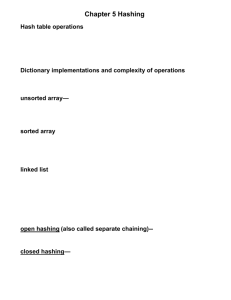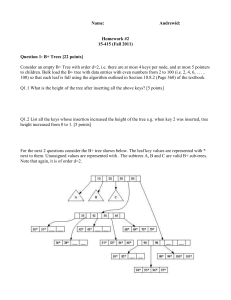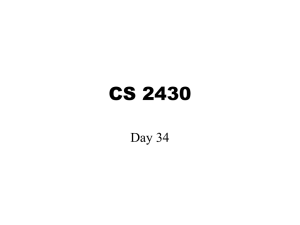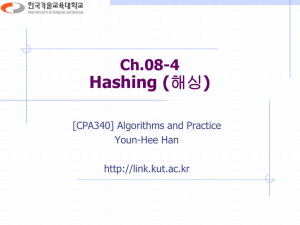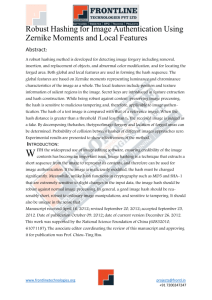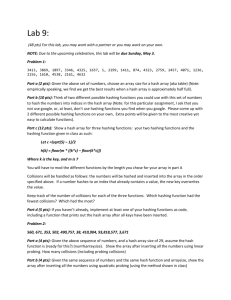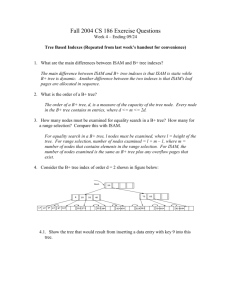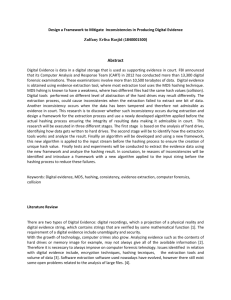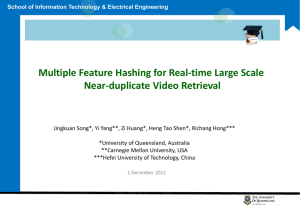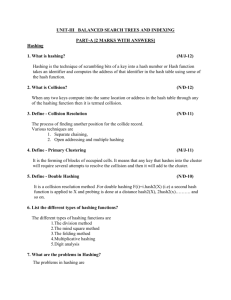Hash_Table
advertisement
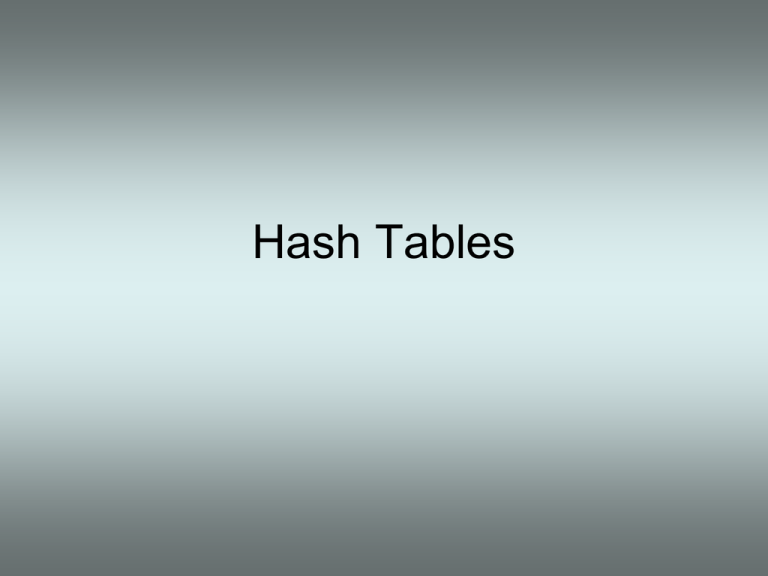
Hash Tables Group Members: Syed Husnain Bukhari Ahmad Inam M.Umair Sharif SP10-BSCS-92 SP10-BSCS-06 SP10-BSCS-38 Description • A hash table is a data structure that stores things and allows insertions, lookups, and deletions to be performed in O(1) time. • An algorithm converts an object, typically a string, to a number. Then the number is compressed according to the size of the table and used as an index. • There is the possibility of distinct items being mapped to the same key. This is called a collision and must be resolved. Key Hash Code Generator Number Compression Smith 7 0 1 2 3 4 5 6 7 8 9 Bob Smith 123 Main St. Orlando, FL 327816 407-555-1111 bob@myisp.com Index Definition: Hashing is a key-to-address mapping process. Terms must be familiarized. Collision: A collision occurs when a hashing algorithm produces an address for an insertion key and that address is already occupied. Home address: The address produced by the hashing algorithm is known as the home address. Prime area: The memory that contains all of the home addresses is known as the prime area. Probe: Each calculation of an address and test for success is known as a probe. Collision Resolution • There are two kinds of collision resolution: 1 – Chaining makes each entry a linked list so that when a collision occurs the new entry is added to the end of the list. 2 – Open Addressing uses probing to discover an empty spot. • With chaining, the table does not have to be resized. With open addressing, the table must be resized when the number of elements is larger than the capacity. Smith 7 Chaining 0 1 2 3 4 5 6 7 8 9 Bob Smith 123 Main St. Orlando, FL 327816 407-555-1111 bob@myisp.com Jim Smith 123 Elm St. Orlando, FL 327816 407-555-2222 jim@myisp.com Smith 7 Probing 0 1 2 3 4 5 Bob Smith 123 Main St. Orlando, FL 327816 407-555-1111 bob@myisp.com 6 7 8 9 Jim Smith 123 Elm St. Orlando, FL 327816 407-555-2222 jim@myisp.com Hashing Methods There are eight hashing methods they are: 1: Direct method 2: Subtraction method 3: Modulo-division 4: Mid square 5: Digit extraction 6: Rotation 7: Folding 8: Pseudorandom generation Hashing Methods • Direct Method In direct hashing the key is the address without any algorithmic manipulation. Direct hashing is limited, but it can be very powerful because it guarantees that there are no synonyms and therefore no collision. • Modulo-division Method This is also known as division remainder method. This algorithm works with any list size, but a list size that is a prime number produces fewer collisions than other list sizes. The formula to calculate the address is: Address = key MODULO listsize + 1 Where listsize is the number of elements in the array. • Example: Given data : Keys are : 137456 214562 140145 137456 % 19 +1 = 11 214562 % 19 + 1 = 15 140145 % 19 + 1 = 2 • Digit-extraction Method Using digit extraction selected digits are extracted from the key and used as the address. Example : Using six-digit employee number to hash to a three digit address (000-999), we could select the first, third, and fourth digits( from the left) and use them as the address. The keys are: 379452 -> 394 121267 -> 112 378845 -> 388 • Folding Method Two folding methods are used they are: 1: Fold shift 2: Fold boundary 1: Fold Shift In fold shift the key value is divided into parts whose size matches the size of the required address. Then the left and right parts are shifted and added with the middle part. • Fold boundary In fold boundary the left and right numbers are folded on a fixed boundary between them and the center number. The two outside values are thus reversed. • Midsquare Method In midsquare hashing the key is squared and the address is selected from the middle of the square number. Limitation is the size of the key. Example: 94522 = 89340304: address is 3403 • Rotation Method Rotation method is generally not used by itself but rather is incorporated in combination with other hashing methods. It is most useful when keys are assigned serially. • Pseudorandom Hashing A common random-number generator is shown below. y= ax + c To use the pseudorandom-number generator as a hashing method, we set x to the key, multiply it by the coefficient a, and then add the constant c. The result is then divided by the list size, with the remainder being the hashed address. Example: Y= ((17 * 121267) + 7) modulo 307 Y= (2061539 + 7) modulo 307 Y= 2061546 Y=41 Hash Table Uses • Compilers use hash tables for symbol storage. • The Linux Kernel uses hash tables to manage memory pages and buffers. • High speed routing tables use hash tables. • Database systems use hash tables. Summary • A hash table is a convenient data structure for storing items that provides O(1) access time. • The concepts that drive selection of the key generation and compression functions can be complicated, but there is a lot of research information available. • There are many areas where hash tables are used. • Modern programming languages typically provide a hash table implementation ready for use in applications. References Knuth, Donald A. The Art of Computer Programming. Philippines: Addison-Wesley Publishing Company, 1973. Loudon, Kyle. Mastering Algorithms with C. Sebastopol: O’Reilly & Associates, 1999 Watt, David A., and Deryck F. Brown. Java Collections. West Sussex: John Wiley & Sons, 2001 Dewdney, A. K. The New Turing Omnibus. New York: Henry Holt and Company, 2001 Any Question

